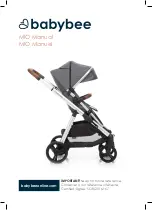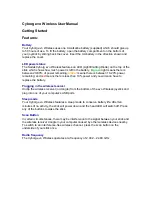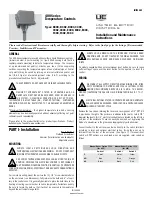
Installation
September 2013
2-23
WARNING
This unit vents the supply medium
into the surrounding atmosphere.
When installing this unit in a
non-hazardous (non-classified)
location in a confined area, with
natural gas as the supply medium,
you must remotely vent this unit to a
safe location. Failure to do so could
result in personal injury or property
damage from fire or explosion, and
area re-classification.
When installing this unit in a
hazardous (classified) location remote
venting of the unit may be required,
depending upon the area
classification, and as specified by the
requirements of local, regional, and
federal codes, rules and regulations.
Failure to do so when necessary
could result in personal injury or
property damage from fire or
explosion, and area re-classification.
Vent line piping should comply with
local and regional codes and should
be as short as possible with adequate
inside diameter and few bends to
reduce case pressure buildup.
In addition to remote venting of the
unit, ensure that all caps and covers
are correctly installed. Failure to do
so could result in personal injury or
property damage from fire or
explosion, and area re-classification.
The relay output constantly bleeds supply medium into
the area under the cover. The vent opening at the
back of the housing should be left open to prevent
pressure buildup under the cover. If a remote vent is
required, the vent line must be as short as possible
with a minimum number of bends and elbows.
To connect a remote vent to DVC6010 and
DVC6030 digital valve controllers and DVC6005
base unit—remove the plastic vent (key 52, figures
8-2 and 8-5). The vent connection is 3/8 NPT internal.
At a minimum, 12.7 mm (1/2-inch) tubing should be
used when installing a remote vent to prevent
excessive pressure from building up under the cover.
To connect a remote vent to DVC6020 digital valve
controllers—replace the standard mounting bracket
(key 74, figures 8-3 and 8-5) with the vent-away
bracket (key 74). Install a pipe plug in the vent-away
mounting bracket (key 74). Mount the digital valve
controller on the actuator as described in the
Installation section of this manual. The vent
connection is 3/8 NPT internal. At a minimum, 12.7
mm (1/2-inch) tubing should be used when installing a
remote vent to prevent excessive pressure from
building up under the cover.
Electrical Connections
WARNING
To avoid personal injury resulting
from electrical shock, do not exceed
the maximum input voltage specified
in table 1-2 of this instruction manual,
or on the product nameplate. If the
input voltage specified differs, do not
exceed the lowest specified maximum
input voltage.
Select wiring and/or cable glands that
are rated for the environment of use
(such as hazardous area, ingress
protection and temperature). Failure
to use properly rated wiring and/or
cable glands can result in personal
injury or property damage from fire or
explosion.
Wiring connections must be in
accordance with local, regional, and
national codes for any given
hazardous area approval. Failure to
follow the local, regional, and national
codes could result in personal injury
or property damage from fire or
explosion.
The valve may move in an unexpected
direction when power is applied to the
DVC6000 digital valve controller. To
avoid personal injury and property
damage caused by moving parts,
keep hands, tools, and other objects
away from the valve/actuator
assembly when applying power to the
instrument.
2
Содержание Fisher FIELDVUE DVC6000
Страница 2: ......
Страница 22: ...DVC6000 Digital Valve Controllers September 2013 1 12 1 ...
Страница 82: ...DVC6000 Digital Valve Controllers September 2013 4 22 4 ...
Страница 94: ...DVC6000 Digital Valve Controllers September 2013 5 12 5 ...
Страница 139: ...Loop Schematics Nameplates September 2013 B 1 B B Appendix B Loop Schematics Nameplates B ...
Страница 161: ......
















































